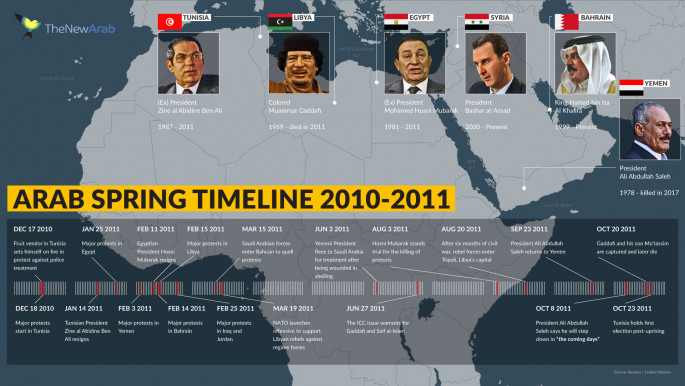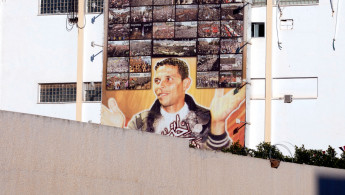Mohamed Bouazizi, 1984-2011: The fire that lit the Arab Spring
For many it was a typical Friday morning in Sidi Bouzid, a small city in the rural heartlands of Tunisia.
Typical was the sight of the poverty-stricken street vendors hawking their wares on the roadside, and typical too was the sight of police officers harassing them in the hunt for bribes.
But when the 26-year-old Mohamed Bouazizi cried 'enough' after a group of officers had set their eyes on his fruit cart and on his meagre income, the day became anything but typical.
Ten years have now passed since that December morning, when the course of everyday life erupted into a conflagration that forever after changed the Arab world.
Bouazizi, a Tunisian street vendor born into economic hardship, set himself on fire in front of the office of Sidi Bouzid's provincial governor on 17 December, 2010.
He had been repeatedly harassed by municipal officers over the day, ostensibly because he had no permit to sell his produce on the streets. More likely it was because he had no funds for a bribe.
With his fruit and cart confiscated, and with officials at the governor's office refusing to hear his pleas, Bouazizi had stood upright in the road as traffic passed by him, doused himself with gasoline, and set himself alight. He remained in a coma until his death on 4 January, 2011.
 |
The self-immolation of Bouazizi rippled across Tunisia and the Arab world, inspiring pro-democracy movements and uprisings that saw the toppling of one Arab dictator after another |  |
The self-immolation of Bouazizi rippled across Tunisia and the Arab world, inspiring pro-democracy movements and uprisings that saw the toppling of one Arab dictator after another.
On the anniversary of Bouazizi's self-immolation – and the birth of the Arab Spring – The New Arab profiles the life of a street vendor whose actions still reverberate across the Arab world today.
A spectre of poverty
Bouazizi was born on 29 March, 1984 in the small village of Sidi Salah, near the city of Sidi Bouzid. One of six siblings, his family lived in modest circumstances during his early years.
Twitter Post
|
His father worked as a labourer and poverty was always around the corner, rearing its head throughout his life. When his father died of a heart attack when Bouazizi was only three, the family income dwindled, and soon all the burdens were to fall on the young boy's shoulders alone.
As was the course for many Tunisians, the young Bouazizi soon became a source of financial support for his mother and younger siblings. His brief education at a small school near the city was interrupted by the requirement for work, with Bouazizi taking on jobs from as early as 10.
As a teenager, he sold seasonal fruits and vegetables from a cart. Soon, circumstances forced him to leave education entirely in search of a better paying job.
Success was nowhere to be found. Applications for positions were rebuffed, a few stints working with an illness-stricken uncle ended as debt forced the fledgling family farm to be taken over, and in his twenties, Bouazizi returned once more to selling on the streets.
Over the same years, when the burdens of being the main breadwinner weighed ever heavier on Bouazizi's shoulders, the palaces of Tunisia's elite grew taller and broader. The reign of Tunisia's then-president Zine El Abidine Ben Ali, which had begun in a coup in 1987, was by then into its third decade.
In the years of Ben Ali's stifling authoritarian government, which saw any opposition stamped out, the classes close to regime power enriched themselves through corruption and embezzlement.
Disparities of wealth were manifested most flamboyantly by the president's own family and in-laws, in whose hands many of the country's major companies lay, and into whose bank accounts much of Tunisia's riches were funnelled.
 |
As the burdens of being the main breadwinner weighed ever heavier on Bouazizi's shoulders, the palaces of Tunisia's elite grew taller and broader |  |
Meanwhile as poverty and unemployment stalked the country, rural regions and cities like Sidi Bouzid were especially hard-hit.
For Bouazizi, the little income there was to be earnt came from his labour as a street vendor and he looked after his siblings, including financing his sister's university education. But life on the street was one filled with harassment.
With the country's security services often operating with impunity, Bouazizi himself lived those years subject to repeated harassment from police and market inspectors, often demanding bribes before leaving him alone.
 |
|
| Click to enlarge |
A cry of despair
Such were the typical days of Bouazizi's life, until on 17 December, 2010 a female market inspector confiscated his cart and produce, alleging he did not have the required permit.
Desperate to defend his right to earn a living, Bouazizi entered a verbal confrontation with the officer. According to witnesses and accounts from his relatives, having already confiscated his cart, the officer then slapped him.
With his produce taken, the despairing Bouazizi went to the provincial headquarters to complain and request that his goods be returned. He was refused an audience.
Without alerting his family, at 11:30am, within an hour of the initial confrontation, he had set himself alight.
 |
Bouazizi died on 4 January, 2011. By then, protests had spread across the country |  |
The touch paper of simmering anger was lit. The people of Sidi Bouzid erupted. Marchers gathered in the streets. The actions of the police, ever used to quelling disturbances with the heaviest of hands, only caused more to spill out of their homes in protest. Riots followed.
Over the days that followed Bouazizi's self-immolation, the events in Sidi Bouzid rippled across the country.
Claims that Bouazizi was a university graduate who had set himself alight over a lack of employment, while erroneous, hit new marks, as the masses from among both urban and rural Tunisians, from farmers to university graduates, took to the streets to protest against the corruption of Ben Ali's rule.
Twitter Post
|
Bouazizi was transferred to a hospital near Tunis. In an attempt to quell the unrest, Ben Ali visited him in hospital on 28 December, 2010. It was too little too late.
Martyr of the revolution
Bouazizi died on the 4 January, 2011. By then, protests had spread across the country. Calls for Ben Ali to resign, which only a few weeks earlier would have been entirely unthinkable, were now being publicly shouted by thousands on the streets of Tunis.
The authorities' attempts to use force to suppress what became known as the Jasmine Revolution drew international outcry, and the meagre concessions offered by Ben Ali and his cronies failed to placate the now emboldened opposition.
On 14 January, ten days after the passing of Bouazizi and less than one month after that atypical Friday morning, Ben Ali stepped down.
From 2010 until today, Bouazizi has been celebrated as a hero of the Tunisian revolution.
While Tunisia has itself gone through major trials and tribulations as a succession of governments have sought to deal with the aftermath of Ben Ali's regime, the distinct status of the 26-year old fruit-seller remains undiminished.
In February 2011, Tunis' main square gained a new name. For the best part of the thirty years it had been known as the November 7 Square, marking the date in 1987 when Ben Ali took power.
Today it stands as Mohamed Bouazizi Square. But on large public squares and roadsides across the country, other street vendors remain hopeful that theirs will never be the life that Bouazizi once faced.
Sarah Khalil is a journalist with The New Arab.
Follow her on Twitter: @skhalil1984



